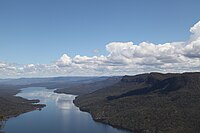Catchment hydrology

Catchment hydrology is like a big sponge. Imagine you have a sponge - if you pour water on it, the sponge will absorb the water! The sponge can hold a lot of water, right? Now, think of a catchment as a big, huge sponge that can hold a lot more water than the small sponge.
A catchment is an area of land where all the water that falls within that area drains into the same river, stream or other body of water. This land can be really big, like the size of a state or country, or it can be small, like the size of a backyard. When it rains or snows, the water that falls onto the ground runs downhill and collects in the rivers or streams that are in the catchment area.
Just like a sponge, a catchment can only hold so much water. When it rains too much, or too fast, the catchment can't hold all the water, and it starts to overflow. This can cause floods and landslides. If the catchment is really dry, it may not have enough water for plants, animals, and people who live there.
Scientists who study catchment hydrology try to understand how water moves through the sponge-like catchment. They want to know how much water is coming into the catchment and how much is leaving. They also want to know how the water moves through the different parts of the catchment, like the soil, rocks, streams, and lakes.
By studying catchment hydrology, scientists can help us understand how water moves through the earth, which can help people to better manage our water resources.
A catchment is an area of land where all the water that falls within that area drains into the same river, stream or other body of water. This land can be really big, like the size of a state or country, or it can be small, like the size of a backyard. When it rains or snows, the water that falls onto the ground runs downhill and collects in the rivers or streams that are in the catchment area.
Just like a sponge, a catchment can only hold so much water. When it rains too much, or too fast, the catchment can't hold all the water, and it starts to overflow. This can cause floods and landslides. If the catchment is really dry, it may not have enough water for plants, animals, and people who live there.
Scientists who study catchment hydrology try to understand how water moves through the sponge-like catchment. They want to know how much water is coming into the catchment and how much is leaving. They also want to know how the water moves through the different parts of the catchment, like the soil, rocks, streams, and lakes.
By studying catchment hydrology, scientists can help us understand how water moves through the earth, which can help people to better manage our water resources.
Related topics others have asked about:
